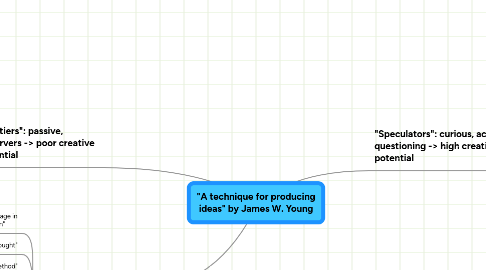
1. "Rentiers": passive, observers -> poor creative potential
2. "Speculators": curious, active, questioning -> high creative potential
2.1. Principles
2.1.1. Ideas are new combinations of old elements (like with a kaleidoscope which multiplies possibilities)
2.1.2. Ideas depend on one's ability to see connections
2.2. Method
2.2.1. 1. Gather raw materials
2.2.1.1. Specific materials: deep knowledge about the product & the consumer (until you understand why they are all different)
2.2.1.2. General materials: be interested in everything & be able to browse info (use a scrapbook or a file to keep info)
2.2.2. 2. Masticate the materials: mentally work on every info / twist it / understand what it implies, write emerging or partial tentative ideas on 3x5cm cards and keep doing it until you have no idea of what is what anymore
2.2.3. 3. Evacuate the topic from your mind (like Sherlock Holmes going out to the theater in the middle of a case)
2.2.4. 4. The idea appears (when you least expext it!)
2.2.5. 5. Fine-tune the idea: it has to fit with the real world (product, laws, market conditions...). Submit your idea to criticism. If it's good, people will be stimulated by this idea / add on it / build on it.
